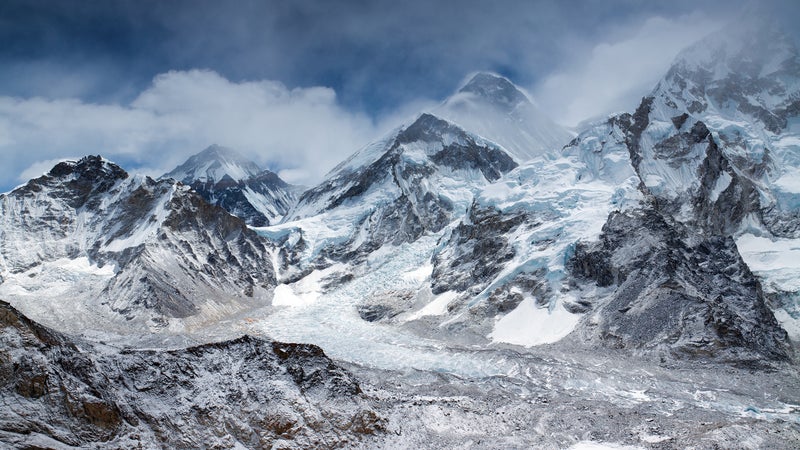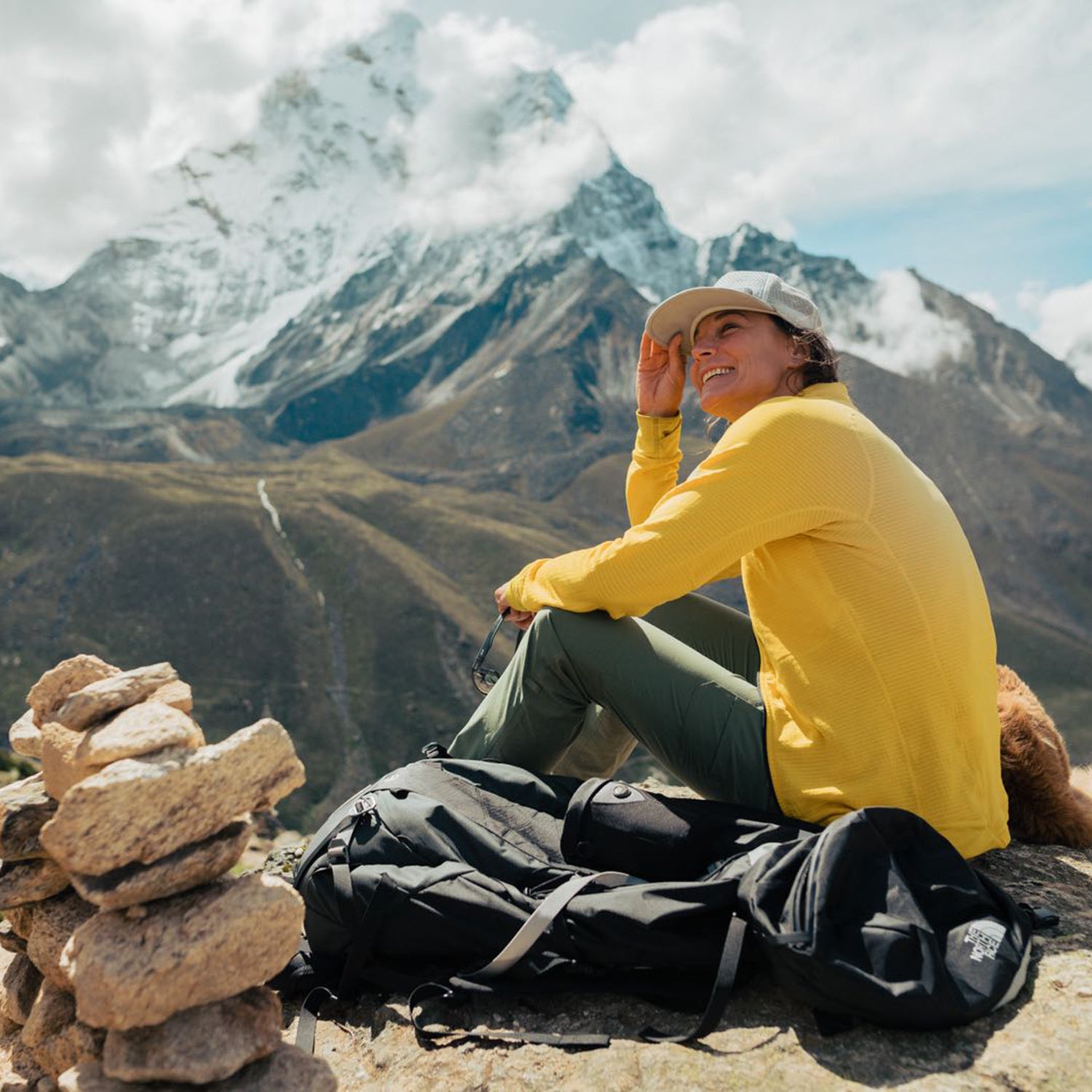In August, American ski mountaineers Hilaree Nelson and Jim Morrison flew to Nepal from their homes in Telluride, Colorado, and Tahoe City, California, respectively, to attempt the first ski descent of 27,940-foot Lhotse. Part of the Everest massif, Lhotse is the fourth-highest mountain in the world. From a skier’s perspective, though, Lhotse is first choice. The summit offers a sustained and direct 7,000-vertical-foot ski line that combines a 2,500-foot couloir and an open face. The average pitch is 45 to 50 degrees. For comparison, the steepest in-bounds black diamond runs in the U.S. top out at about 30 degrees.
“It is this iconic, splinter couloir and it just screams ski line to me,” Morrison told me earlier this��summer.��“It’s this plum line right off the summit, right down the middle onto this huge face that goes way down. And it’s never been done.”
Until this summer, of the five tallest mountains in the world, Mount Everest was the only one to have been skied successfully from the summit. Then, in July, a Polish alpinist named Andrezj Bargiel skied off the summit of K2, the second-highest mountain in the world.
The previous handful��of��attempts to ski Lhotse by athletes like Adrian Ballinger, Kristoffer��Erickson, and Jamie Laidlaw,��have been done in the spring, during Nepal’s popular climbing season. However, Nelson and Morrison timed their trip intentionally for this fall, at the end of monsoon season, when the high peaks are covered in snow.��
Nelson and Morrison are two of the most experienced��ski mountaineers in the world. Together, they have climbed and skied Denali (20,310 feet) in Alaska and Papsura (21,165 feet), known as the “peak of evil,” in India. This spring, Morrison skied Cho Oyu and sections on Everest (though not from top). And though she’s never attempted to ski it, Nelson has climbed Lhotse before. In 2012, she and Erickson linked Lhotse with Mount Everest, making Nelson the first woman to climb two 8,000-meter peaks in 24 hours. She remembers thinking how much more comfortable she was climbing up a couloir on Lhotse than a ridge on Everest. A couloir is familiar terrain for a skier, said Nelson. The thought of skiing definitely crossed her mind, but at the time, there was no snow. “Even though it was all rock and ice then, all I could think was, wow. This thing is incredible, probably the most aesthetic couloir in high altitude that I’ve seen,” she said.
On September 12, Nelson sent me two voice memos from Everest��Base Camp,��giving me beta on what the route looks like. Earlier that day, the pair had climbed to Pumori Camp I��at 19,000 feet to acclimatize and Nelson said they walked on a little bit of snow, just below the freezing line. “It’s definitely thick, wet, and punchy,” she said. “But we just got our first glimpse of the Lhotse Face today. You can’t see the Lhotse Couloir from anywhere except the regular route��on Everest, but you can see the whole Lhotse Face, and it’s definitely caked with snow. Now we just have to get up there and see what it’s like.”

They are the only team at Everest Base Camp��right now. The timing was ideal not only for the snow, but also for the absence of other climbers attempting to ascend Lhotse. “Lhotse has become quite a popular climb,” said Nelson. “Because it’s so popular, it’s such a pinner couloir, that if you had four or five people in it, it would be impossible to ski.”
On the other hand, their solitude��makes the route-building that much more difficult. Nelson and Morrison are planning to climb Lhotse with five Sherpas. Their team will have to break trail without support for 11,000 feet of elevation gain. “That’s a lot of boot packing,” said Nelson.
From Base Camp, they will move slowly up the mountain. They plan to spend one night at Camp I, above the Khumbu Icefall, before moving on to Camp II at 21,000 feet. Camp III is at 23,000 feet. Depending on whether or not they use supplemental oxygen, they will either attempt the summit directly from Camp III or set up another camp at the foot of the couloir. The route follows a ramp straight into a 2,500-foot couloir that gradually narrows to the width of a ski—though it could be wider, depending on the snowpack. At the bottom of the couloir, the slope widens to a vast 5,000-foot-long apron that is skiable all the way until Camp II.��
That is, it will be, if Nelson and Morrison get their skis in time.��Monsoon conditions prevented the team from flying a fixed-wing plane with all of their gear—over 2,000 pounds, Nelson estimated—to Lukla, the airport that climbers traditionally embark from to access the Everest Base Camp. Instead, they chartered a helicopter to fly the core members of the team—including Nelson, Morrison, and filmmakers Dutch Simpson and Nick Kalisz, who are documenting the expedition. Porters are slowly bringing up the rest of their gear. A plan to bring their skis to Everest Base Camp by helicopter fell through tragically. Just after flying the Lhotse team,�� killing the pilot and five others. Only one passenger survived.
This tragedy also complicates the Lhotse Team’s plans to traverse the Khumbu Icefall. Widely considered to be one of the most dangerous stages of climbing Everest and Lhotse, the Khumbu Icefall is a glacial river with deep crevasses and requires ladders and ropes for safe passage. It is also melting, making it unpredictable and risky. In April,��a 300-foot section collapsed and injured two Sherpas. Nelson and Morrison will be traveling with Icefall Doctors, Sherpas who specialize in route-setting through this kind of terrain. To limit their exposure to risk in this zone, they had planned to fly a lot of their gear by helicopter over the Icefall to the higher elevation camps. “We are going to do our best to make the whole climb as safe as we can,” said Nelson.
Nelson isn’t sure exactly when the team will begin the traverse, but is aiming��to start through the Icefall in the next four or five days to get to Camp II. After the Icefall, Nelson and Morrison will face avalanche exposure. The slope’s steep angle will hopefully work in their favor, in this regard, with loose snow naturally sloughing off the mountain.
The skiing will be equally intense. In high altitudes, bad conditions with breakable crust and sastrugi—grooves in the ridges created by wind and weather that are notoriously hard to ski—are almost guaranteed. “That means they’re going to be doing jump turns, and jump turns are way more physical than walking downhill,” said��Ballinger, an Everest mountain guide who was the first person to ski 26,759-foot Manaslu, the eighth-tallest mountain in the world. Ballinger has also skied Cho Oyu twice, and attempted to ski Lhotse. He’s good friends with both Nelson and Morrison. “In my experience, when I’m above 8,000 meters, if I’m linking five turns in a row before I’m bent over and trying not to puke in my oxygen mask, I’m pretty psyched. It’s exhausting, powerful skiing.”


